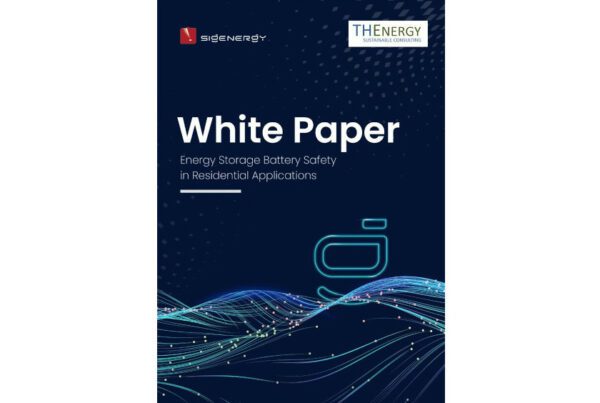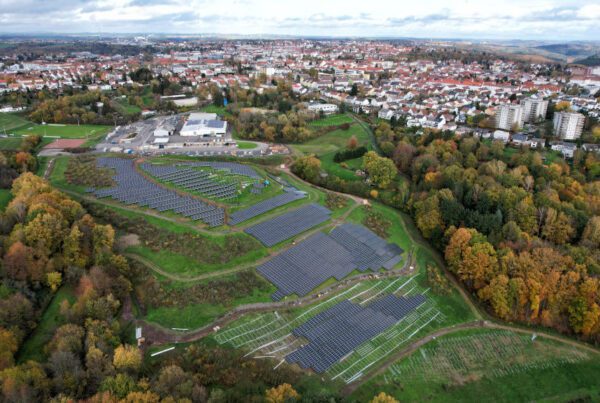With the latest generation of household devices increasingly connected and internet-of-things (IoT)-enabled, dye-sensitized solar cells can finally realize their latent promise and help reduce the carbon footprint of billions of manufactured goods.
As solar PV becomes increasingly common, the world has gained a better understanding of how it converts sunshine to electricity. From solar arrays large enough to power entire towns to portable solar panels dynamic enough to charge cell phones, companies are continually exploring and expanding the bounds of how light can be used to power everyday life in ever more sustainable ways.
 100vw, 323px”><figcaption class=) Bates Marshall, CEO of Ambient Photonics.
Bates Marshall, CEO of Ambient Photonics.
Image: Ambient Photonics
Dye-sensitized solar cells (DSSC) are a prime example. They were first developed in the late 1980s to mimic the natural absorption of light energy and convert any visible light – not just direct sunlight – into electrical energy. Despite a relatively low cost of production, however, the power density of dye-sensitized cells was not competitive with conventional silicon solar technology so DSSCs remained little more than a novelty for 30 years.
What did hold promise, however, was the performance of such devices in low-light conditions, such as indoors or in shaded outdoor locations, even if those early DSSCs offered performance little better than the amorphous silicon cells used on solar-powered calculators. Fast forward to today, and breakthrough advances in chemistry and design have made low-light solar cells more efficient and offer higher power density, opening up new market possibilities.
The timing could not be better. Society’s reliance on connected devices – and IoT – has led to the manufacture of billions of consumer electronic devices and sensors. This is raising concern about IoT’s impact on the environment, as disposable batteries inside such devices significantly contribute to e-waste and carbon emissions. Low-light cells, however, show how the solar industry can lead a new area of decarbonization in such appliances.
Low-light power
Almost half of IoT sensors are installed inside buildings, where variable low-light conditions are the norm. PV technology such as those amorphous silicon calculator cells does not yield sufficient power in real-world, low-light operational conditions to power connected devices. At the same time, high-performance, low-light PV technology, such as gallium arsenide cells, come with a price tag that has made them suitable only for space satellite and research applications, not mass-market electronics.
Today’s low-light solar cells – including those being developed by my company, Ambient Photonics – can harvest energy from indirect and artificial light to create an endless power source for a myriad of devices. Indoor light and outdoor low-light environments are dynamic and generally gloomier than assumed. As a result, they require breakthrough power density to deliver reliable performance. Achieving high power dye-sensitized solar cells at competitive price points not only opens up new sustainability opportunities for device manufacturers, it also throws open the doors for design possibilities appliance engineers cannot achieve with disposable battery-powered devices.
Decarbonizing the supply chain
Rooftop solar has become an effective, accessible solution for companies to offset emissions from their building operations by generating on-site electricity. While this effectively reduces what are known as “scope 1” and “scope 2” carbon emissions, there is still a disconnect between putting solar on the roof of a factory and the actual products being manufactured inside the building. Re-examining how products are made in the supply chain, with their associated “scope 3” emissions, the solar industry can provide more than just large scale generation, it can become the source of power for everyday life.
When it comes to electronic devices, for instance, a logical change manufacturers make along the supply chain, which leverages the advantages of solar, is to eliminate disposable batteries.
Popular content
Consider the case of a remote control. German battery manufacturer Varta estimates each AAA battery has lifetime greenhouse gas equivalent emissions of 61 g of CO2. Most remote controls require two AAA batteries that last around a year, with average use. The average lifetime of a remote control is seven years, requiring 14 batteries during that time.
According to the U.S. Environmental Protection Agency, approximately three billion batteries are sold in the United States alone each year, averaging 32 per family, or 10 per person. The typical consumer owns two button batteries and 10 A, AA, AAA, C, D or 9 V dry cell batteries, and throws out eight household batteries per year. Even in environmentally conscious California, only 0.55% of alkaline batteries are recycled.
Besides generating mountains of hazardous waste in landfill, the production and disposal of batteries itself has a large carbon footprint. By harvesting energy from everyday light, through the use of low-light solar cells to replace disposable batteries, manufacturers can more quickly achieve electronic device sustainability goals – particularly by reducing scope 3 supply chain emissions.
Solar beyond sunlight
Power is a meta resource, as much of today’s modern world revolves around consumer electronic devices and equipment. In the coming decade, the potential exists for billions more devices and wireless sensors to enter the market. However, the challenge of reliably, affordably, and sustainably powering these devices has continued to limit IoT viability at scale.
Energy harvesting technology is a transformative, once-in-a-generation, world-changing advancement, and low-light solar cells put the solar industry once again in a powerful position to lead decarbonization on a huge scale.
About the author: Bates Marshall is co-founder and CEO of California-based low-light solar cell manufacturer Ambient Photonics, which employs a novel industrial solar printing technology to coat its proprietary chemistry on thin, durable glass substrates.
The views and opinions expressed in this article are the author’s own, and do not necessarily reflect those held by pv magazine.
This content is protected by copyright and may not be reused. If you want to cooperate with us and would like to reuse some of our content, please contact: editors@pv-magazine.com.



